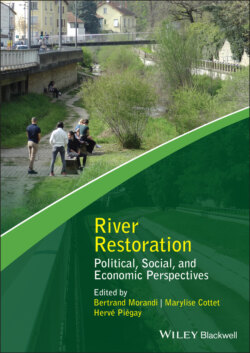Читать книгу River Restoration - Группа авторов - Страница 19
1.3 A scientific community organized regionally and occasionally around river restoration projects
ОглавлениеSmith et al. (2014, p. 253) writes that “the integration of social science into restoration is relatively rare.” Indeed, while research in the field of river restoration emerged in the 1970s and grew significantly from the early 1990s, studies specifically focused on societal issues only emerged in the 1990s and remained limited in number until the mid‐2000s (Figure 1.2). Although societal approaches still represent a minority of the published work in the field of river restoration, it is a steadily growing minority. Over the decade 2010–2020, work on the social, economic, or political stakes of restoration represented 10% of all publications devoted to river restoration, whereas it represented only 5% in the 2000s and 2% in the 1990s. The results of this work seem to be increasingly mobilized by the interdisciplinary scientific community. According to WoS data, studies dedicated to societal issues are cited almost as much as studies addressing other topics in restoration (2.4 vs. 2.6 annual citations).
Figure 1.2 Chronology of international scientific publications on societal issues in river restoration.
The first works on societal issues listed in the WoS date from the 1990s, with these being published in Europe and the United States (e.g. Barendregt et al. 1992; Loomis 1996; Turner and Boyer 1997). Over the entire period, 72% of all publications dedicated to social, economic, and political issues were written by researchers from European and North American institutions, with 36% being written by US researchers alone. However, societal publications represent only 6% of all work in the field of river restoration published in the USA (Figure 1.3). Some countries, which publish less in the field of restoration, are proportionally more active on societal issues. This is the case for several European countries including Spain, Switzerland, Norway, and to a lesser extent Germany, which have been actively publishing since 2005. Studies published in Israel also give particular importance to work in economics (e.g. Axelrad and Feinerman 2009; Becker and Friedler 2013). Researchers from East Asian countries, whose first publications in the field of river restoration date back to the mid‐2000s (Nakamura et al. 2006), very quickly became interested in societal issues (e.g. Tanaka 2006; Jia et al. 2010; Che et al. 2012). As a proportion of the total work they publish on river restoration, some countries, such as Taiwan, South Korea, Japan, and China, are among the most active on societal issues. In total, since the early 1990s, more than 400 authors from 31 countries have contributed to publications on societal issues in the field of river restoration.
Despite publications from a large number of countries, there does not seem to be an internationally structured scientific community around humanities and social sciences. While most of the publications listed in the WoS involve authors belonging to different institutions, a minority are the result of international institutional cooperation. Scientific communities do exist, but they are multifaceted and rather structured on national or even regional scales. Sometimes it is more accurate to speak of scientific teams than communities. While these teams contribute to the production of societal knowledge in the field of restoration, they are often structured around broader or related research issues. Thus, significant works on river restoration have been published by a network of researchers from several English universities working on flooding and public perception issues (e.g. Tunstall et al. 1999, 2000; Eden et al. 2000; Åberg and Tapsell 2013). Also, in Switzerland, in the canton of Zurich, a scientific community specializing in public participation issues has produced notable work in the field of river restoration (e.g. Schläpfer and Witzig 2006; Junker and Buchecker 2008; Seidl and Stauffacher 2013). The dynamics of regionalized research often seem temporary. Several researchers, whose work is now a reference in the field, have only had a momentary commitment to restoration issues (e.g. Pahl‐Wostl 2006; Junker and Buchecker 2008; Buijs 2009). Out of more than 400 identified authors, less than one‐tenth have participated in multiple publications on the topic of river restoration.
Figure 1.3 Geography of international scientific publications on societal issues in river restoration (1992–2019).
The ad hoc nature of scientific commitments can be explained by the fact that research is often conducted in connection with the implementation of fixed‐duration restoration projects. The bibliometric analysis identified more than a hundred rivers for which research was undertaken on societal issues related to the implementation of restoration projects (Figure 1.4). Some of these projects are known mainly through these societal studies. For example, in South Korea, several research teams (notably attached to universities in Seoul province) have worked on the social, economic, and political evaluation of the restoration of the Cheonggyecheon and Anyancheon rivers, two rivers that are now emblematic of urban restoration (e.g. Lee and Jung 2016; Kim et al. 2017). In Israel and the Palestinian Territories, it is economists who have published scientific literature on restoration projects on the Yarqon, Jordan, and Kishon rivers (e.g. Becker et al. 2014; Garcia et al. 2016). Societal research has also focused on emblematic river restoration projects conducted on major rivers such as the Rhine (e.g. Buijs 2009), Danube (e.g. Bliem et al. 2012), Colorado (e.g. Bark et al. 2016), Sacramento (e.g. Golet et al. 2006), and Kissimmee (e.g. Chen et al. 2016). It is often in the context of such projects that an interdisciplinary culture is forged. In France, several studies on the social and political issues involved in the restoration of the Rhône (e.g. Barthélémy and Armani 2015; Guerrin 2015) were developed as part of a global approach to long‐term socioecological research (Lamouroux et al. 2015; Thorel et al. 2018). Similarly, research on the Cole River and Skerne River (Tunstall et al. 1999; Eden and Tunstall 2006; Åberg and Tapsell 2013) in the United Kingdom was undertaken as part of an interdisciplinary European project (Holmes and Nielsen 1998).
